Convert DELTA
Convert DELTA file to SDD or EML
With this form you can directly convert data from a file in DELTA format
into an XML file according schema SDD 1.1 rev5. No connection
to a database is needed for the conversion. Choose Data ->
 File operations ->
File operations ->
 Convert data file →
Convert data file →  DELTA to SDD … from the menu to open the window. In the window click
on the
DELTA to SDD … from the menu to open the window. In the window click
on the  button to
select the file with the data you want to convert. If the Multi-file
option is selected before pressing the
button to
select the file with the data you want to convert. If the Multi-file
option is selected before pressing the
 button, a folder
selection window opens to select the folder where the DELTA files are
located. For muti-file processing currently the files “chars”, “items”,
“specs” and “extra” are evaluated. If during analysis any problem
occurs, you may click on the
button, a folder
selection window opens to select the folder where the DELTA files are
located. For muti-file processing currently the files “chars”, “items”,
“specs” and “extra” are evaluated. If during analysis any problem
occurs, you may click on the  button to reload the
file and re-initialize the window.
button to reload the
file and re-initialize the window.

The contents of the file will be shown in the upper part of the File
tree tab page. If special characters are not displayed corretly, try a
different Encoding setting, e.g. “ANSI”, and reload the document
using the  button.
button.
The Insert “variable” state controls the handling of the DELTA state
“V” for categorical summary data. If possible, a categorical state
“variable” is inserted to the descriptor data and set in the summary
data, when the state “V” is present in the description data.
If the Check strings for illegal characters option is checked, all
string literals that shall be exported from database are scanned for
illegal non-printable characters and matches are replaced by a double
exclamation mark ("‼"). Activating this option may increase the analysis
processing time.
In the file tree you may deselect entries that shall not be converted.
Use that option very carefully, because if you deselect entries that are
being referenced by other parts of the input tree, e.g. descriptors
referenced by descriptions, the analysis step might become erronous!
If during reading of the files expressions cannot be interpreted,
suspicious entries are maked with yellow background
(warning) in the file tree. When you move the mouse curser over
the marked entries, you get additional information as tool tip or the
tree node text itself tells the problem (see example below).

Analysis
To analyse the data in the file click on the Analyse data
 button. During
the analysis the program checks the dependencies between the different
parts of the data and builds up an analysis tree in the lower part of
the window. The analysis tree contains all data in a suitable format for
the final step. During data analysis the icon of the button changes to
button. During
the analysis the program checks the dependencies between the different
parts of the data and builds up an analysis tree in the lower part of
the window. The analysis tree contains all data in a suitable format for
the final step. During data analysis the icon of the button changes to
 and you may abort processing by clicking the
button.
and you may abort processing by clicking the
button.
In the Analysis settings section (see image below) you set the
document’s Language. You man change the display and sorting of the
entries in the Language combo box from “<code> - <description>”
to “<description> - <code>” (and back) by clicking the button
 . If you need language codes that are not included
in the list, click the
. If you need language codes that are not included
in the list, click the  edit button. For more details
see Edit language codes.
edit button. For more details
see Edit language codes.
The Insert “variable” state controls the handling of the DELTA state
“V” for categorical summary data. If possible, a categorical state
“variable” is inserted to the descriptor data and set in the summary
data, when the state “V” is present in the description data.
If the Check strings for illegal characters option is checked, all
string literals that shall be exported from database are scanned for
illegal non-printable characters and matches are replaced by a double
exclamation mark ("‼"). Activating this option may increase the analysis
processing time.
In DELTA text in angle bracket (<text>) usually denotes comments,
which are by default imported into the “Details” fields of the database.
In the lower parts of the Analysis settings you may adjust a
different handling for description, descriptor and categorical state
items.
- For DELTA comments in descriptions you may Move comments to
details (default) or Keep comments in description titles.
- For DELTA comments in descriptors you may Move comments to
details (default), Move comments to notes or Keep comments in
descriptor titles.
- For DELTA comments in categorical states you may Move comments
to details (default) or Keep comments in categorical state
titles.
After changing one of these settings click on the Analyse data
 button to make
the changes effective.
button to make
the changes effective.

After analysis a message window informs you if any warnings or errors
occured. You can find detailled error and warning information at the
file and/or analysis trees by entries with red text
(error) or yellow background
(warning). When you move the mouse curser over the marked
entries, you get additional information as bubble help or the tree node
text itself tells the problem (see example below). By clicking on the
status text besides the progress bar, you can open an analysis protocol
(see below, right).


If an analysis error occured, you are not able to proceed. You will
first have to correct the problem, e.g. by excluding the erronous
descriptor in the example above (after reloading the file). If a warning
occured, it might not cause further problems, but you should take a
closer look if the converted data will be correct.
Write data
Pressing the Generate file
 button in the
Write SDD group box opens a window to select the target XML file. By
default the target file has the same name as the DELTA file, followed by
the extension “.xml”. The Comptible option controls generation of
files with most possible compatibility to the SDD standard. On the other
hand some data might not be present in the generated file, if this
option is activated.
button in the
Write SDD group box opens a window to select the target XML file. By
default the target file has the same name as the DELTA file, followed by
the extension “.xml”. The Comptible option controls generation of
files with most possible compatibility to the SDD standard. On the other
hand some data might not be present in the generated file, if this
option is activated.
As an additional option you may generate file according the EMLschema,
which consists of a data table (tabulator separated text file) and an
XML file that contains the metadata including column descriptions. Click
on the Generate file
 button in the
Write EML group box. The generated file names will have the endings
"_EML_DataTable.txt" and "_EML_Metadata.xml".
button in the
Write EML group box. The generated file names will have the endings
"_EML_DataTable.txt" and "_EML_Metadata.xml".
Pressing the drop down button  EML
settings in the Write EML group box opens the EML writer options.
You can chose to include a special sign for empty column values or set
the columns values in quotes (see left image below). Furthermore you may
shose the column separator (tab stop rsp. comma) an decide if multiple
categorical states shall be inserted as separate data columns. If you
already generated EML files, the used settings will be automatically
saved and you may restore them using the option
EML
settings in the Write EML group box opens the EML writer options.
You can chose to include a special sign for empty column values or set
the columns values in quotes (see left image below). Furthermore you may
shose the column separator (tab stop rsp. comma) an decide if multiple
categorical states shall be inserted as separate data columns. If you
already generated EML files, the used settings will be automatically
saved and you may restore them using the option
 Load last write settings. Finally click
button
Load last write settings. Finally click
button  EML settings to close the option
panel.
EML settings to close the option
panel.
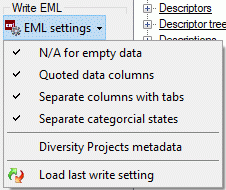
Handling of special DELTA states
In the DELTA format the special states “-” (not applicable), “U”
(unknown) and “V” (variable) are available for categorical and
quantitative characters. These states are treated in the folloging
manner during import:
- “-” (not applicable)
The data status “Not applicable” is set.
- “U” (unknown)
The data status “Data unavailable” is set.
- “V” (variable)
The data status “Not interpreterable” is set.
Convert SDD
Convert SDD file to DELTA or EML
With this form you can directly convert data from a file in XML file
according schema SDD 1.1 rev5 into a DELTA
file. No connection to a database is needed for the conversion. Choose
Data →  File operations ->
File operations ->
 Convert data file →
Convert data file →  SDD
to DELTA … from the menu to open the window. In the window click on
the
SDD
to DELTA … from the menu to open the window. In the window click on
the  button to select
the file with the data you want to convert. If during analysis any
problem occurs, you may click on the
button to select
the file with the data you want to convert. If during analysis any
problem occurs, you may click on the  button to
reload the file and re-initialize the window.
button to
reload the file and re-initialize the window.
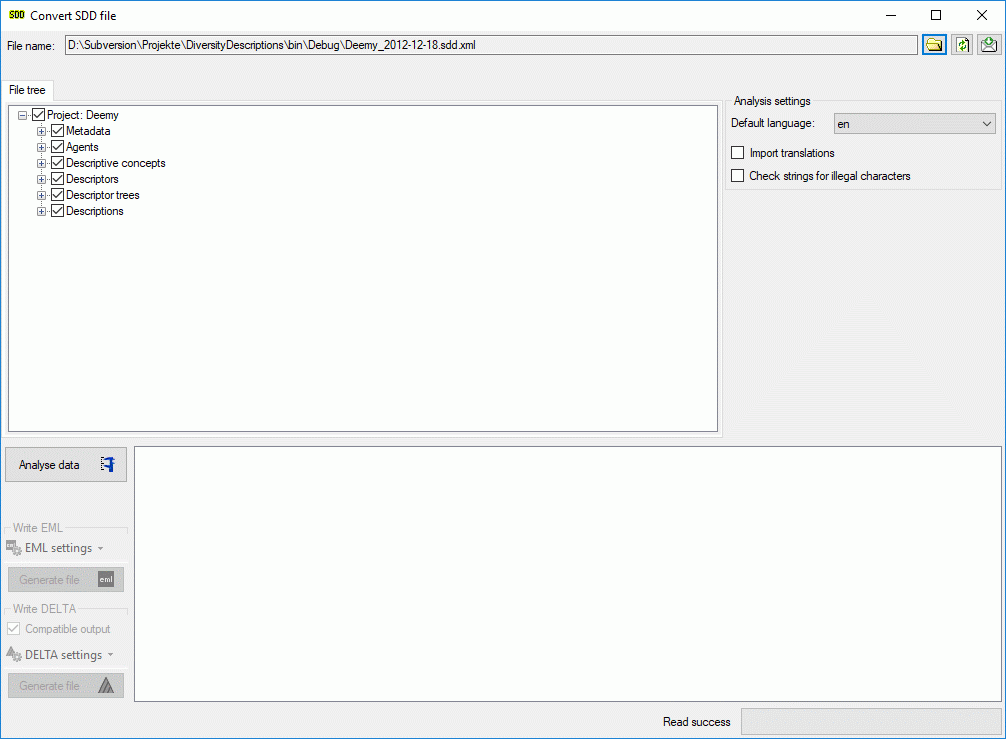
The contents of the file will be shown in the upper part of the File
tree tab page. In the Analysis settings part you find the
documents’ default language. If additional laguages are contained in the
document, you may select one of them as the new language of the DELTA
file. By checking Import translations you select all additional
document languages for the analysis step. This option is automatically
pre-selected if more than one language has been found in the file. In
the bottom part of the window you find the actual processing state.
In the file tree you may deselect entries that shall not be imported
into the database. Use that option very carefully, because if you
deselect entries that are being referenced by other parts of the input
tree, e.g. descriptors referenced by descriptions, the analysis step
might become erronous!
Analysis
To analyse the data in the file click on the Analyse data
 button. During
the analysis the program checks the dependencies between the different
parts of the data and builds up an analysis tree in the lower part of
the window. The analysis tree contains all data in a suitable format for
the final step. During data analysis the icon of the button changes to
button. During
the analysis the program checks the dependencies between the different
parts of the data and builds up an analysis tree in the lower part of
the window. The analysis tree contains all data in a suitable format for
the final step. During data analysis the icon of the button changes to
 and you may abort processing by clicking the
button.
and you may abort processing by clicking the
button.
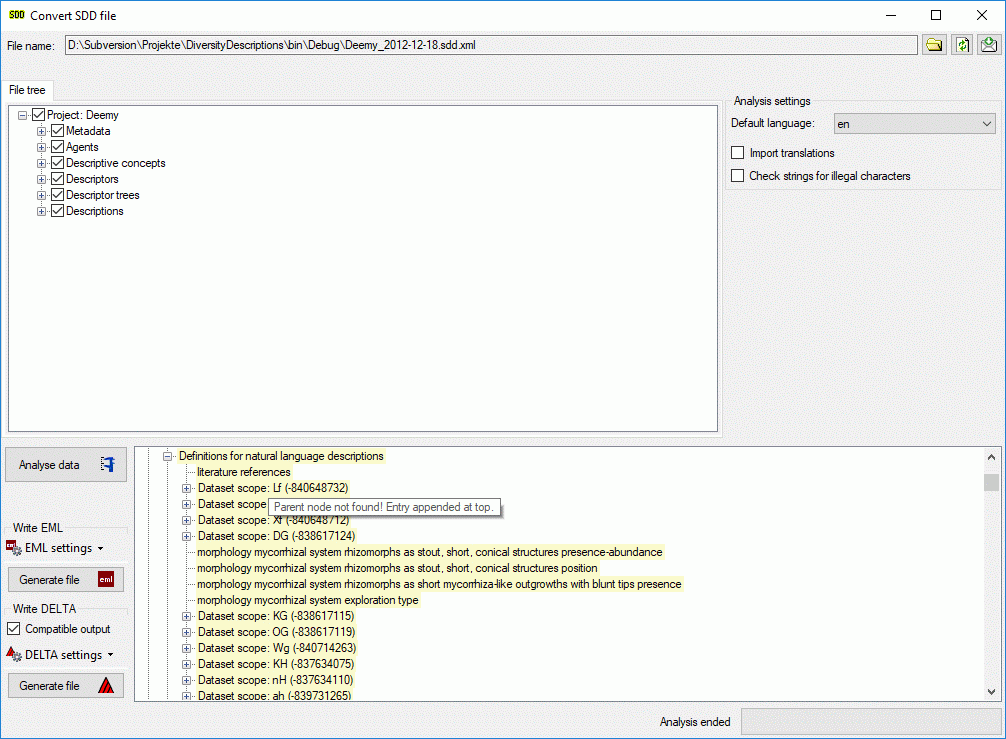
After analysis a message window informs you if any warnings or errors
occured. You can find detailled error and warning information at the
file and/or analysis trees by entries with red text
(error) or yellow background
(warning). When you move the mouse curser over the marked
entries, you get additional information as tool tip or the tree node
text itself tells the problem (see examples below). By clicking on the
status text besides the progress bar, you can open an analysis protocol
(see below, right).



If an analysis error occured, you are not able to proceed. You will
first have to correct the problem, e.g. by excluding the erronous
descriptor in the example above (after reloading the file). If a warning
occured, it might not cause further problems, but you should take a
closer look if the converted data will be correct.
Write data
Pressing the Generate file
 button in the
Write Delta group box opens a window to select the target delta
file. By default the target file has the same name as the SDD file,
followed by the extension “.dat”. The Comptible option controls
generation of files with most possible compatibility to the DELTA
standard. On the other hand some data might not be present in the
generated file, if this option is activated.
button in the
Write Delta group box opens a window to select the target delta
file. By default the target file has the same name as the SDD file,
followed by the extension “.dat”. The Comptible option controls
generation of files with most possible compatibility to the DELTA
standard. On the other hand some data might not be present in the
generated file, if this option is activated.
As an additional option you may generate file according the EMLschema,
which consists of a data table (tabulator separated text file) and an
XML file that contains the metadata including column descriptions. Click
on the Generate file
 button in the
Write EML group box. The generated file names will have the endings
"_EML_DataTable.txt" and "_EML_Metadata.xml".
button in the
Write EML group box. The generated file names will have the endings
"_EML_DataTable.txt" and "_EML_Metadata.xml".
Pressing the drop down button  DELTA
settings in the Write DELTA group box opens the DELTA writer
options. You can chose to include some detail text and notes in the
DELTA output (see left image below). For descriptions, descriptors or
categorical states the details will be appended as DELTA comments
(included in angle brackets “< … >”) to the respective titles. The
notes will be appended as DELTA comments of the corresponding summary
data. If you already generated DELTA files, the used settings will be
automatically saved and you may restore them using the option
DELTA
settings in the Write DELTA group box opens the DELTA writer
options. You can chose to include some detail text and notes in the
DELTA output (see left image below). For descriptions, descriptors or
categorical states the details will be appended as DELTA comments
(included in angle brackets “< … >”) to the respective titles. The
notes will be appended as DELTA comments of the corresponding summary
data. If you already generated DELTA files, the used settings will be
automatically saved and you may restore them using the option
 Load last write settings. Finally click
button
Load last write settings. Finally click
button  DELTA settings to close the
option panel.
DELTA settings to close the
option panel.
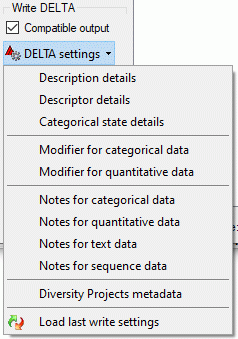

Pressing the drop down button  EML
settings in the Write EML group box opens the EML writer options.
You can chose to include a special sign for empty column values or set
the columns values in quotes (see right image above). Furthermore you
may shose the column separator (tab stop rsp. comma) an decide if
multiple categorical states shall be inserted as separate data columns.
If you already generated EML files, the used settings will be
automatically saved and you may restore them using the option
EML
settings in the Write EML group box opens the EML writer options.
You can chose to include a special sign for empty column values or set
the columns values in quotes (see right image above). Furthermore you
may shose the column separator (tab stop rsp. comma) an decide if
multiple categorical states shall be inserted as separate data columns.
If you already generated EML files, the used settings will be
automatically saved and you may restore them using the option
 Load last write settings. Finally click
button
Load last write settings. Finally click
button  EML settings to close the option
panel.
EML settings to close the option
panel.
Handling of special sequence data
While SDD can handle molecular sequence data, for DELTA export these
data will be exported as text data. To preserve the sequence specific
descriptor data, they will be inserted into the text character as a
special comment with the format, e.g. “#6. Sequence descriptor
<[SequenceCharacter][ST:N][SL:1][GS:-][/SequenceCharacter]>/”.
If the analysis tree includes sample data, they will be included as
items at the end of the DELTA file. The naming of those spetial items
will be <description name> - <event name> - Unit <number>.
Sampling event data will not be included in the DELTA file.
 Convert SDD file: Read an
XML file according to the SDD schema 1.1 rev 5 and generate DELTA or EML
files.
Convert SDD file: Read an
XML file according to the SDD schema 1.1 rev 5 and generate DELTA or EML
files. Convert DELTA file: Read
DELTA text file(s) and generate SDD or EML files.
Convert DELTA file: Read
DELTA text file(s) and generate SDD or EML files. Check SDD file: Check if a
text file is an XML file according to the SDD schema 1.1 rev 5.
Check SDD file: Check if a
text file is an XML file according to the SDD schema 1.1 rev 5. Check EML file: Check if a
text file is an XML file according to the EML schema 2.1.1.
Check EML file: Check if a
text file is an XML file according to the EML schema 2.1.1.
 File operations ->
File operations ->
 Check EML file … from the menu. After
opening the window shown below the schema files will be automatically
loaded. You may select the schema that shall be used with combo box
Schema version (see image below). Starting with
DiversityDescriptions v. 4.3.5 the EML export will be done using EML
2.2.0.
Check EML file … from the menu. After
opening the window shown below the schema files will be automatically
loaded. You may select the schema that shall be used with combo box
Schema version (see image below). Starting with
DiversityDescriptions v. 4.3.5 the EML export will be done using EML
2.2.0.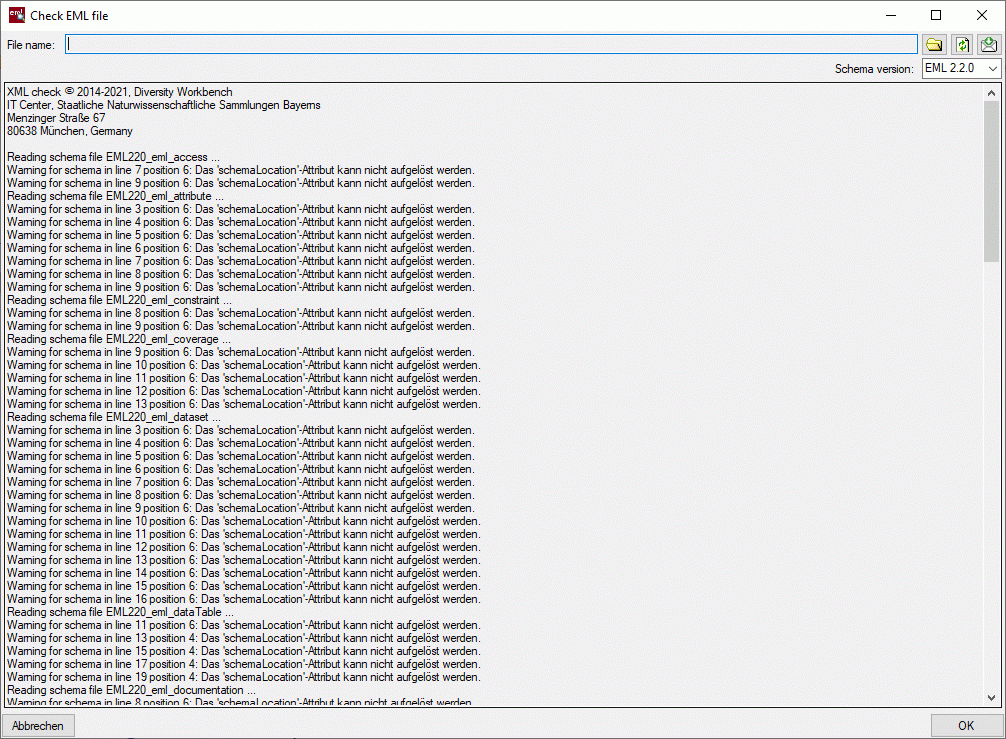
 button to select the
file you want to check. The check results will be diplayed in the center
part of the window. By clicking the reload button
button to select the
file you want to check. The check results will be diplayed in the center
part of the window. By clicking the reload button  you can start a new check (see image below).
you can start a new check (see image below). 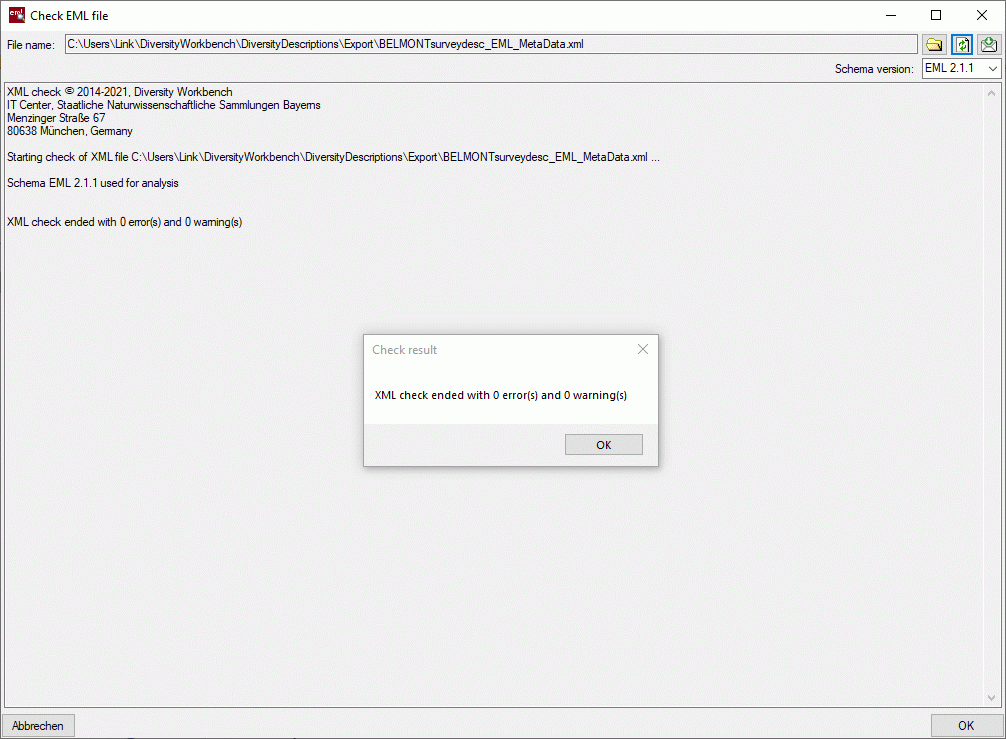

 Check SDD file … from the menu. After
opening the window shown below the schema files will be automatically
loaded.
Check SDD file … from the menu. After
opening the window shown below the schema files will be automatically
loaded.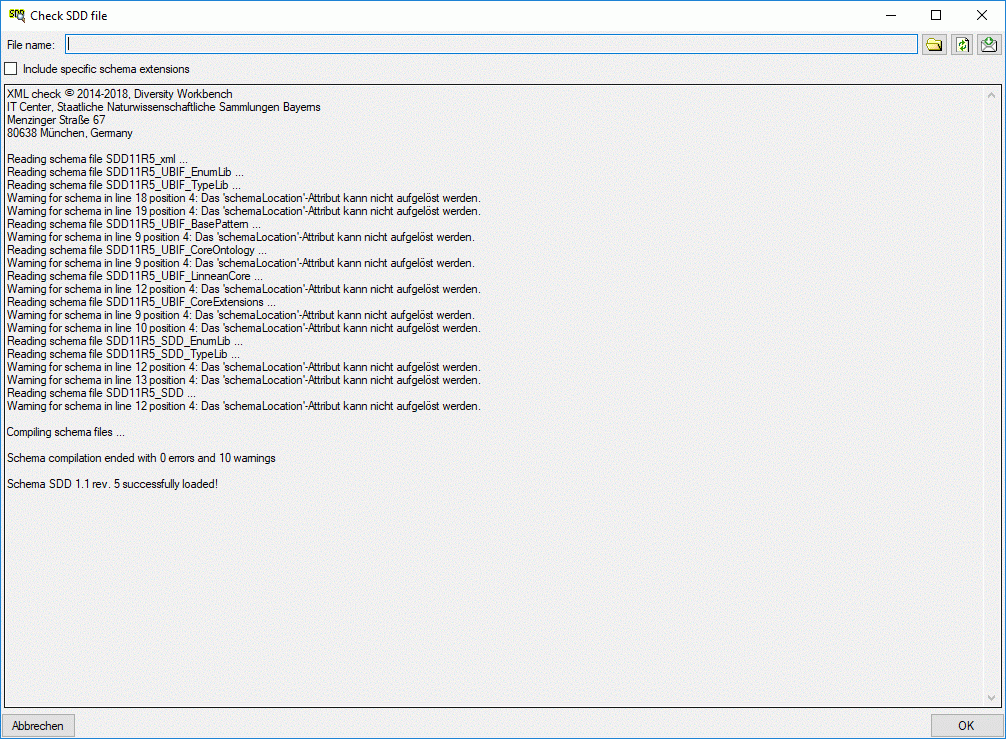


 Convert data file →
Convert data file → 

 button. During
the analysis the program checks the dependencies between the different
parts of the data and builds up an analysis tree in the lower part of
the window. The analysis tree contains all data in a suitable format for
the final step. During data analysis the icon of the button changes to
button. During
the analysis the program checks the dependencies between the different
parts of the data and builds up an analysis tree in the lower part of
the window. The analysis tree contains all data in a suitable format for
the final step. During data analysis the icon of the button changes to
 and you may abort processing by clicking the
button.
and you may abort processing by clicking the
button.  . If you need language codes that are not included
in the list, click the
. If you need language codes that are not included
in the list, click the  edit button. For more details
see
edit button. For more details
see 


 button in the
Write EML group box. The generated file names will have the endings
"_EML_DataTable.txt" and "_EML_Metadata.xml".
button in the
Write EML group box. The generated file names will have the endings
"_EML_DataTable.txt" and "_EML_Metadata.xml". EML
settings in the Write EML group box opens the EML writer options.
You can chose to include a special sign for empty column values or set
the columns values in quotes (see left image below). Furthermore you may
shose the column separator (tab stop rsp. comma) an decide if multiple
categorical states shall be inserted as separate data columns. If you
already generated EML files, the used settings will be automatically
saved and you may restore them using the option
EML
settings in the Write EML group box opens the EML writer options.
You can chose to include a special sign for empty column values or set
the columns values in quotes (see left image below). Furthermore you may
shose the column separator (tab stop rsp. comma) an decide if multiple
categorical states shall be inserted as separate data columns. If you
already generated EML files, the used settings will be automatically
saved and you may restore them using the option
 Load last write settings. Finally click
button
Load last write settings. Finally click
button 




 DELTA
settings in the Write DELTA group box opens the DELTA writer
options. You can chose to include some detail text and notes in the
DELTA output (see left image below). For descriptions, descriptors or
categorical states the details will be appended as DELTA comments
(included in angle brackets “< … >”) to the respective titles. The
notes will be appended as DELTA comments of the corresponding summary
data. If you already generated DELTA files, the used settings will be
automatically saved and you may restore them using the option
DELTA
settings in the Write DELTA group box opens the DELTA writer
options. You can chose to include some detail text and notes in the
DELTA output (see left image below). For descriptions, descriptors or
categorical states the details will be appended as DELTA comments
(included in angle brackets “< … >”) to the respective titles. The
notes will be appended as DELTA comments of the corresponding summary
data. If you already generated DELTA files, the used settings will be
automatically saved and you may restore them using the option
